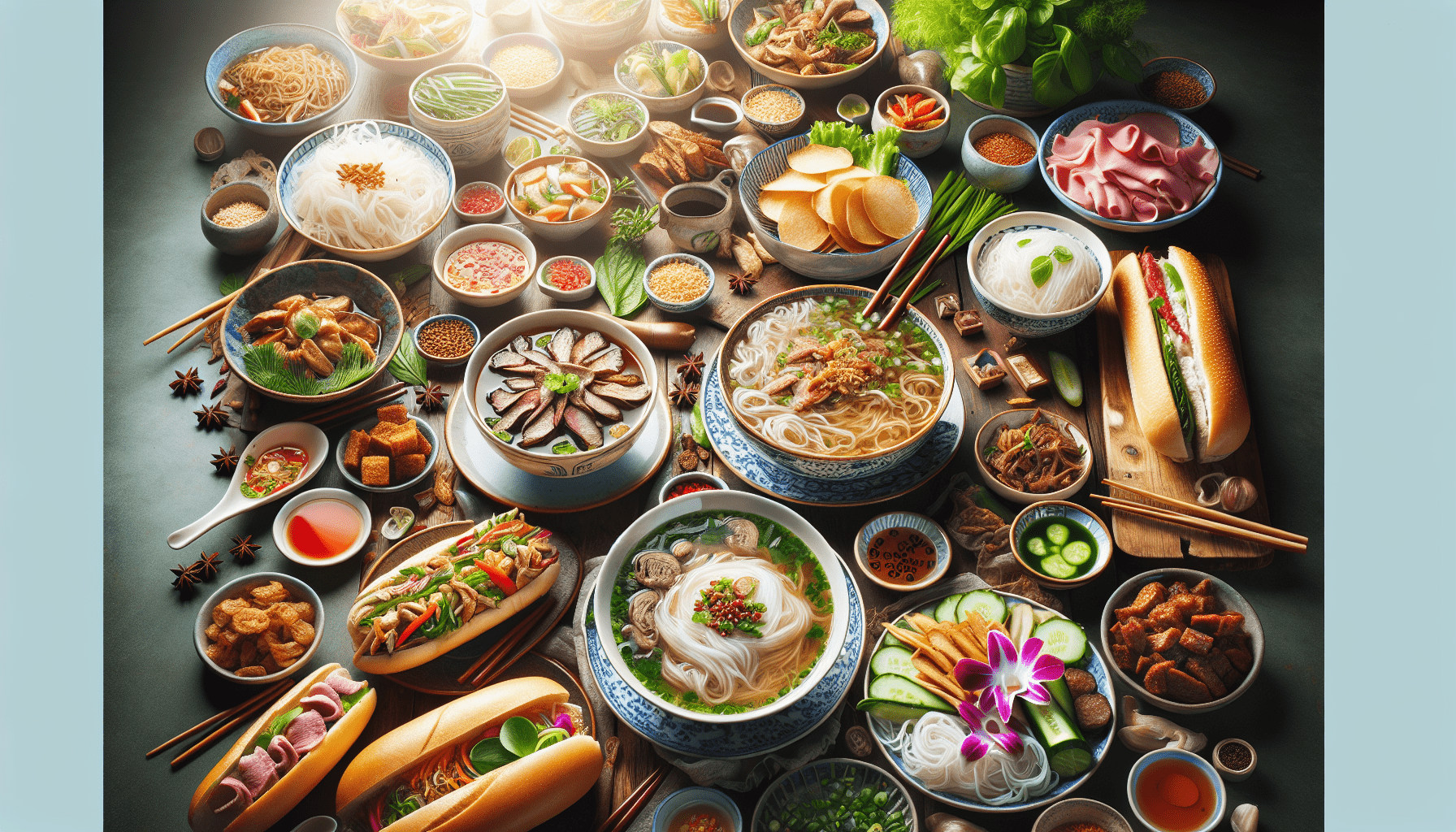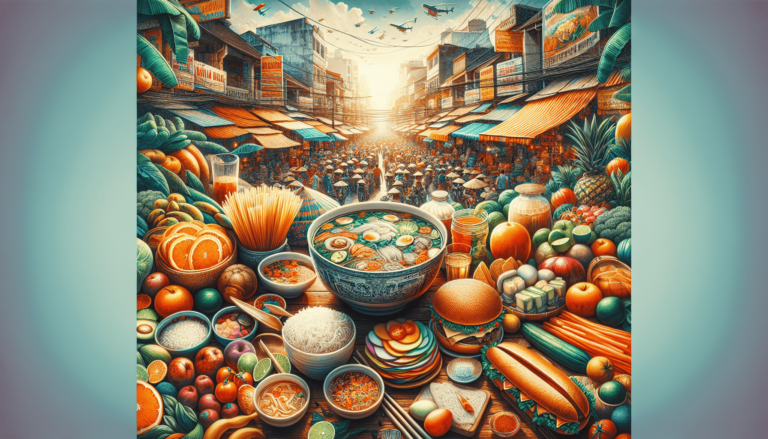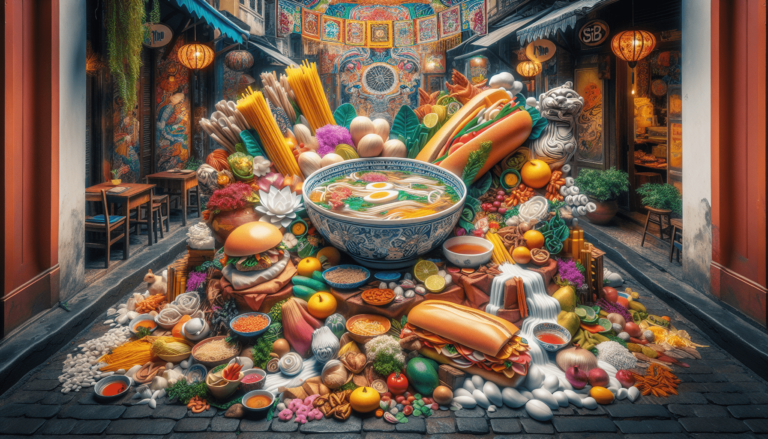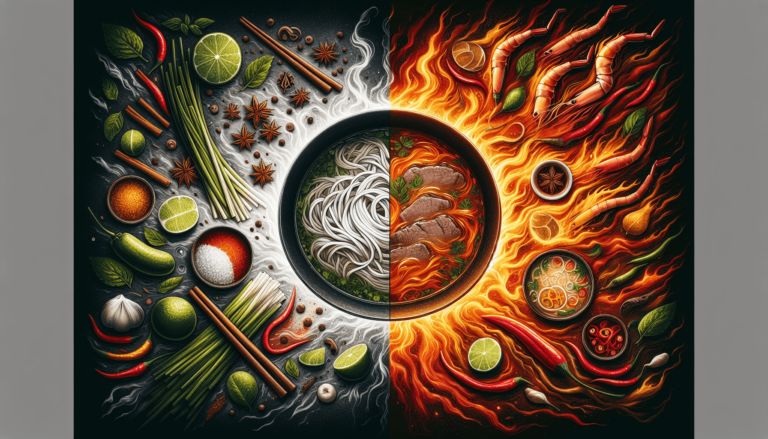In Vietnam, rice takes center stage as the staple food. From the bustling streets of Ho Chi Minh City to the tranquil rice terraces of Sapa, this grain is an essential part of Vietnamese cuisine. But it’s not just the plain white rice that steals the show. Vietnamese cuisine embraces a variety of rice dishes, each with its own unique flavors and textures. From fragrant jasmine rice to savory sticky rice, rice is the backbone of Vietnamese meals, accompanying a diverse array of vibrant and flavorful dishes. Whether you’re a fan of the classic pho or the zesty banh mi, you can be sure that rice plays a vital role in every Vietnamese culinary creation. So, if you’re looking to indulge in the heart and soul of Vietnamese cuisine, head to any of the Eurasian Bistro locations in Pensacola for a taste of Vietnam’s staple food.
Overview of Vietnamese Cuisine
Vietnamese cuisine is renowned for its delicate flavors, fresh ingredients, and vibrant colors. It is a harmonious fusion of flavors from various regions of Vietnam and is deeply influenced by the country’s agricultural heritage. Rice, as the staple food, forms the foundation of Vietnamese cuisine. It is accompanied by an array of vegetables, herbs, meats, and seafood to create a balance of flavors and textures. In this article, we will delve into the essence of Vietnamese cuisine, explore the role of rice, showcase examples of common Vietnamese dishes, discuss the influence of rice on Vietnamese culture, and provide insights into preparing rice-based dishes.
Rice as the Staple Food of Vietnam
Rice holds immense significance in Vietnamese culture and is considered the staple food of the nation. It is consumed in almost every meal, whether it’s breakfast, lunch, or dinner. Vietnamese people have a deep connection with rice, and it forms an integral part of their daily lives. The consumption of rice can be traced back to thousands of years, and it reflects Vietnam’s agrarian roots.
In Vietnam, there are various types of rice consumed, each with its own unique characteristics. One of the most popular varieties is jasmine rice, known for its fragrant aroma and soft texture. Other types of rice commonly eaten in Vietnam include sticky rice, glutinous rice, and black rice. Each variety adds its own distinct flavor and texture to the dishes.
Rice cultivation in Vietnam is a labor-intensive process that involves meticulous care. Farmers follow traditional methods, such as hand planting and harvesting, to ensure the quality of the crop. The fertile lands of the Mekong Delta and Red River Delta are the primary areas where rice is grown. The cultivation of rice is deeply intertwined with Vietnamese traditions and serves as a source of cultural pride.

Varieties of Rice-based Dishes
Vietnamese cuisine offers a wide range of rice-based dishes that showcase the versatility of rice as an ingredient. One such iconic dish is Pho, a flavorful rice noodle soup that embodies the essence of Vietnamese comfort food. It typically consists of rice noodles, aromatic herbs, tender slices of beef or chicken, and a fragrant broth that is brewed for hours.
Another popular rice-based dish is Com Tam, which features broken rice as its main component. Com Tam is often served with grilled pork, a fried egg, pickled vegetables, and a side of fish sauce. The combination of textures and flavors in Com Tam creates a delightful culinary experience.
Bun Thit Nuong is a dish that showcases the delicate balance of flavors in Vietnamese cuisine. It combines grilled pork, rice vermicelli noodles, fresh herbs, and vegetables. The smoky flavors of the grilled pork, combined with the freshness of the herbs, create a harmonious blend that is both satisfying and refreshing.
Banh Mi, a Vietnamese sandwich with French influence, is another popular rice-based dish that has gained international recognition. It typically consists of a crispy baguette filled with a variety of savory ingredients, such as pate, cold cuts, pickled vegetables, and fresh herbs. The fusion of Vietnamese and French flavors in Banh Mi is a testament to Vietnam’s rich culinary heritage.
Influence of Rice on Vietnamese Culture and Traditions
Rice plays a vital role in Vietnamese culture and traditions. It is not only an essential part of the daily diet but also holds symbolic significance in various aspects of Vietnamese life. In celebrations and festivals, rice is used as an offering to ancestors and deities as a sign of gratitude and abundance. Rice cakes, known as Banh Chung and Banh Tet, are commonly prepared during the Lunar New Year and are considered auspicious foods.
In addition to its role in celebrations, rice is also an integral part of religious and ritualistic practices in Vietnam. It is used in ceremonies such as weddings, funerals, and temple offerings. Rice holds deep spiritual meaning as a symbol of sustenance and is believed to bring good fortune and blessings.
On a day-to-day basis, rice is a staple for Vietnamese households. It provides sustenance and nourishment for the entire family. The act of sharing a meal together, with rice as the centerpiece, fosters a sense of community and togetherness. Rice serves as a unifying element that brings people together, reinforcing the cultural fabric of Vietnamese society.

Preparing Rice-based Dishes
Preparing rice-based dishes requires skill and attention to detail. Each dish has its own unique preparation process that involves a combination of cooking techniques and flavors. Let’s explore the methods of preparing some popular rice-based dishes in Vietnamese cuisine.
To make Pho, start by simmering aromatic spices such as star anise, cinnamon, and cloves in a pot of beef or chicken broth. The spices infuse the broth with their flavors, creating a fragrant base. Rice noodles are cooked separately and then added to the broth along with thinly sliced beef or chicken. The soup is garnished with fresh herbs, bean sprouts, lime, and chili to add a burst of freshness and contrasting flavors.
Com Tam begins with cooking broken rice until it is fluffy and tender. In a separate pan, marinated pork is grilled to perfection, creating a smoky and savory component. Alongside the grilled pork, a fried egg is prepared to accompany the rice. Pickled vegetables, such as carrots and daikon, are served on the side. A drizzle of fish sauce completes the dish, adding a tangy and umami flavor.
For Bun Thit Nuong, the key is to marinate the pork in a combination of lemongrass, garlic, and fish sauce. The marinated pork is then grilled until it is caramelized and charred, creating a smoky flavor. Rice vermicelli noodles are boiled until they are soft and springy. The dish is assembled by placing the grilled pork on top of the noodles, along with fresh herbs, lettuce, and pickled vegetables. A dipping sauce made with fish sauce, lime juice, sugar, and chili is served on the side for added flavor.
Banh Mi starts with preparing a crispy baguette by baking it until it has a golden crust. The baguette is then filled with a combination of savory ingredients, such as pate, cold cuts, pickled vegetables, fresh herbs, and a spread of mayonnaise. The result is a sandwich that combines crunchy textures, tangy flavors, and a harmonious blend of Vietnamese and French influences.
Local Ingredients in Vietnamese Cuisine
Vietnamese cuisine is renowned for its use of fresh and local ingredients. Vegetables, herbs, and spices play a crucial role in enhancing the flavors of Vietnamese dishes. Commonly used vegetables include bean sprouts, cabbage, lettuce, carrots, daikon, and cucumbers. These vegetables add crunch, texture, and vibrant colors to the dishes.
Vietnamese cuisine also incorporates a wide array of fresh herbs, such as mint, cilantro, Thai basil, and perilla leaves. These herbs impart a refreshing aroma and a burst of flavor, elevating the taste profile of the dishes.
Spices are used judiciously to add depth and complexity to Vietnamese cuisine. Popular spices include star anise, cinnamon, cloves, ginger, lemongrass, and chili. Each spice adds its own unique flavor and aroma, creating a harmonious blend of tastes.
When it comes to meats and seafood, pork, beef, chicken, and shrimp are commonly used in Vietnamese cooking. These proteins are often marinated with a combination of flavorful ingredients, such as garlic, lemongrass, fish sauce, and soy sauce. The preparation of meats and seafood varies depending on the dish, ranging from grilling to stir-frying to slow cooking.
Vietnamese cuisine also makes use of local fruits in both savory dishes and desserts. Fruits such as mango, jackfruit, lychee, and dragon fruit find their way into salads, stir-fries, and refreshing desserts. The inclusion of fruits adds a touch of sweetness and balances the flavors of the dishes.
Health Benefits of Vietnamese Cuisine
Vietnamese cuisine offers a range of health benefits due to its emphasis on fresh ingredients, balanced flavors, and cooking techniques. Rice, being the staple food, is rich in carbohydrates, providing a steady source of energy. It is low in fat and cholesterol, making it a healthier option compared to other staple foods.
The inclusion of vegetables and herbs in Vietnamese dishes provides an abundance of vitamins, minerals, and dietary fiber. These components contribute to overall well-being and aid in maintaining a healthy digestive system.
Meats and seafood used in Vietnamese cuisine are generally leaner and lower in fat compared to other cuisines. Grilling, stir-frying, and slow cooking techniques are employed, minimizing the need for excessive oil and promoting healthier cooking methods.
The use of spices, such as ginger and lemongrass, not only adds flavor but also offers potential health benefits. Ginger is known for its anti-inflammatory properties, while lemongrass aids in digestion and boosts the immune system.
The balanced flavors in Vietnamese cuisine, achieved through a combination of sweet, sour, salty, and spicy elements, satisfy the palate without relying on excessive amounts of sugar or sodium. This makes Vietnamese cuisine a healthier option for individuals seeking flavorful yet nutritious meals.
Regional Variations in Vietnamese Cuisine
Vietnam’s regional diversity is reflected in its cuisine, with distinct variations across the country. The three main regions – Northern, Central, and Southern Vietnam – each have their own unique culinary traditions and specialties.
Northern Vietnamese cuisine is characterized by simple, subtle flavors and a preference for lighter broths and soups. Pho, the iconic rice noodle soup, hails from this region and is a staple in Northern Vietnamese households. Another notable dish is Bun Cha, which consists of grilled pork served with rice noodles, fresh herbs, and a dipping sauce.
Central Vietnamese cuisine is known for its bold and spicy flavors, influenced by the imperial city of Hue. Banh Xeo, a crispy pancake filled with pork, shrimp, and bean sprouts, is a popular dish from this region. Bun Bo Hue, a spicy beef noodle soup, is another beloved specialty that showcases the vibrant flavors of Central Vietnam.
In Southern Vietnam, the cuisine is characterized by its sweetness and the use of coconut milk. Hu Tieu Nam Vang, a pork and shrimp noodle soup, is a signature dish from the region. Southern Vietnamese cuisine also features a wide array of tropical fruits and vegetables, resulting in refreshing salads and desserts.
The regional variations in Vietnamese cuisine showcase the diverse culinary heritage of the country, making it a fascinating and exciting culinary journey.
Influence of Other Cultures on Vietnamese Cuisine
Vietnamese cuisine has been shaped by the influences of various cultures throughout history. The most significant influences come from Chinese and French cuisines, as well as neighboring Southeast Asian countries.
Chinese cuisine has had a profound impact on Vietnamese culinary traditions. The migration of the Chinese to Vietnam introduced new ingredients, cooking techniques, and flavors. The use of stir-frying, dumplings, and soy-based sauces can be traced back to Chinese culinary influence. Dishes such as Banh Cuon, a steamed rice roll, and Mi Hoanh Thanh, a wonton noodle soup, have Chinese origins but have been adapted to suit Vietnamese tastes.
French colonization in Vietnam during the 19th and 20th centuries left an indelible mark on Vietnamese cuisine. The French brought with them baguettes, pate, and coffee, which have now become an integral part of Vietnamese cuisine. The fusion of French and Vietnamese flavors can be seen in dishes like Banh Mi, which combines French-style bread with Vietnamese fillings, creating a unique blend of culinary traditions.
Vietnam’s geographic proximity to neighboring Southeast Asian countries has resulted in the borrowing of certain elements from their cuisines. Thai, Cambodian, and Laotian influences can be found in Vietnamese dishes. However, Vietnamese cuisine has distinct characteristics that set it apart, such as the emphasis on fresh herbs, delicate flavors, and the use of fish sauce as a condiment.
The culinary journey of Vietnamese cuisine is a testament to the country’s rich history and its ability to adapt and transform borrowed elements into unique and beloved dishes.
Where to Experience Authentic Vietnamese Cuisine
To truly savor the essence of Vietnamese cuisine, one must experience it in an authentic setting. Eurasian Bistro, with its locations in Pensacola, provides an excellent opportunity to embark on a culinary journey through Vietnam’s diverse flavors. The bistro offers a menu that showcases the best of Vietnamese cuisine, prepared with traditional techniques and fresh ingredients.
When dining at Eurasian Bistro, be sure to try Pho, the iconic rice noodle soup that captures the soul of Vietnamese comfort food. The rich and aromatic broth, combined with tender slices of beef or chicken and fresh herbs, will transport you to the bustling streets of Vietnam.
For a taste of Southern Vietnamese cuisine, order Hu Tieu Nam Vang, a flavorful pork and shrimp noodle soup that embodies the vibrant flavors of the region. The combination of tender meat, succulent shrimp, and chewy rice noodles is a culinary delight.
If you are in the mood for a fusion of Vietnamese and French flavors, indulge in a Banh Mi. Eurasian Bistro’s Banh Mi features a crispy baguette filled with a variety of savory ingredients, providing a harmony of textures and flavors that will leave your taste buds craving for more.
In addition to these iconic dishes, Eurasian Bistro offers a diverse menu that showcases the best of Vietnamese cuisine. Whether you are a seasoned enthusiast or a newcomer to Vietnamese food, Eurasian Bistro is the perfect destination to embark on a culinary adventure.
To learn more about Eurasian Bistro locations in Pensacola and their menu offerings, visit their website here: Eurasian Bistro Locations
Immerse yourself in the world of Vietnamese cuisine and experience the flavors that have captivated the hearts of millions. Discover the delicate balance of flavors, the vibrant colors, and the cultural richness that make Vietnamese cuisine an unforgettable culinary experience.







